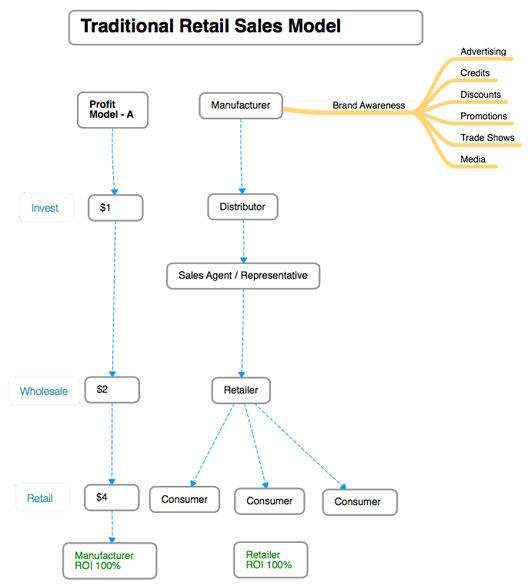
Retailers Protected Council
RetailersProtected.com
THE TRADITIONAL RETAIL SALES MODEL


The Traditional Retail Model
The traditional retail model shows that manufacturers sell to retailers at a wholesale cost, and then retailers typically sell the goods to the end consumer at a mark-up price. This behavior creates a mutually beneficial market environment for manufacturers, retailers, consumers and everyone in between. Market equilibrium, employment, well-established retail communities, innovation, new products, and consumer variety are the benefits of maintaining a traditional retail model.
The equilibrium along the supply chain (manufacturers, retailers, consumers, etc.) is a key characteristic of the traditional retail model. Manufacturers profit from retailers, retailers profit from consumers, and consumers gain by having options and a choice in which products they purchase. Average gross profit margins may differ among industries, but in the traditional retail model each level of distribution gets a piece of the metaphorical pie.
In the traditional retail model, retailers remain in their rightful place as the liaison between producers and the end consumer. Other areas that thrive within the traditional retail model include magazines, industry/trade publications, advertising agencies, sales personnel, and trade show organizations to name a few.
A strong retail presence in the market creates jobs that fuel the economy at a local, national, and global scale. As of February 2014, the U.S. Bureau of Labor Statistics reported more than 15 million Americans are directly employed in the retail industry¹, this includes retail associates, clerks, retail managers and owners. Millions more Americans work indirectly in the retail industry, like those in the wholesale and distribution industries-proving that the retail industry is a viable source for employment.
Additionally, market entrance for new businesses, designers and new products is an advantage found in the traditional retail model due to the multitude of established retail stores, both brick-and-mortar and retail e-commerce. Consumers’ benefit by having a wide range of products, stores and brands in which to shop.
The traditional retail model maintains market stability-creating jobs, innovation, and selection, while allocating profit down the supply chain (see Retail Profit Models graph). As we progress further into the 21st century, more and more manufacturers are deviating from the traditional retail model, bypassing retailers and selling directly to consumers through manufacturer websites. This is morphing the way manufacturers and retailers buy, sell and distribute products to the end consumer, resulting in almost total annihilation of the traditional retail system.
Visit the "New Online Direct Sales" tab to read more about this business model.
by:
Rodrigo Cano, BBA, MBA
Retailers Protected Council
Founder / President
Author / Publisher
rodrigo@retailersprotected.com
Copyright © 2014 Rodrigo Cano. All Rights Reserved.